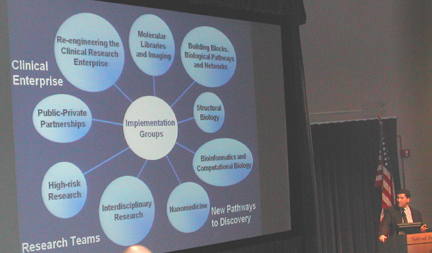| AT THE STARTING POINT OF THE ROADMAP | |||
 |
 |
||
|
On the Map (left photo): Dushanka Kleinman (at podium), NIDCR deputy director and assistant director for implementation of the NIH Roadmap for Medical Research, moderated a briefing that featured key organizers of the programs to reach the three main Roadmap objectives. Shown here are (l. to r.): NCCAM Director Stephen Straus, Amy Patterson, director of the NIH Office of Biotechnology Activities, and NIAMS Director Stephen Katz (Re-engineering the Clinical Research Enterprise); Ellie Ehrenfeld, chief of the NIAID Picornavirus Replication Section, and NIDCR Director Lawrence Tabak (Research Teams of the Future); and NIGMS Director Jeremy Berg and NIMH Director Thomas Insel (New Pathways to Discovery); (right photo): NIH Director Elias Zerhouni tracks the Roadmap's nine implementation routes |
|||
|
With the doubling of the NIH budget came a re-emphasis on NIH obligations to the public health, chief among them the need to translate laboratory discoveries into bedside therapies even more rapidly. "But you can’t translate a language you do not understand," NIH Director Elias Zerhouni said, outlining the nine implementation routes mapped out to develop the tools and teams needed to grasp the emerging complexity of biological systems. The data generated in the last decade, Zerhouni said at a briefing for the NIH community, exceed the existing intellectual and physical tools to process them. That will change with implementation of the NIH Roadmap, an intricate and comprehensive plan for generating, understanding, and applying knowledge relevant to human health. Hundreds of NIH investigators are already involved in particular Roadmap journeys—
—and the process is wide open for input from every interested party at NIH, said Dushanka Kleinman, in charge of Roadmap implementation. She said the two-hour session was intended "to give you just a little flavor of the incredible richness" of the project. She urged investigators to check out the Roadmap website for details and to sign on to the Roadmap LISTSERV. Every IC, Kleinman said, has a Roadmap liaison, "or contact me directly, and I will match you up" with the group of particular interest, she suggested. The briefing session can be accessed at this site. —fp
|
|||
|
NCCAM LECTURE The NCCAM series of Distinguished Lectures in the Science of Complementary and Alternative Medicine continues Wednesday, March 31, with Bruce McEwen, professor and head of the neuroendocrinology lab at New York’s Rockefeller University. The lecture—"From Molecules to Mind: Stress, Individual Differences, and the Social Environment"—will be held from 12:00 to 1:00 p.m. in Masur Auditorium, Building 10. Videocast is available. For more information visit the NCCAM website or contact Kate Haessler at (301) 348-1662 or this address. This event
is free and open to the public. |
The first annual NIH Graduate Student Research Symposium will be held in Masur Auditorium on April 23, 2004, from 8:45 a.m. (registration, breakfast) to 5. NIH Director Elias Zerhouni will open the conference, and Harold Varmus, former NIH director, will be among the featured speakers. Graduate students
from more than 50 universities who are completing their doctoral
research in NIH laboratories through the Graduate
Partnerships Program will
present their research in talks and poster sessions. An "outstanding
mentor" will be honored. |
||
|
Recording for the Blind and Dyslexic (RFB&D) needs science readers! RFB&D provides recorded textbooks for blind and dyslexic students and currently has a much greater demand for college and postgraduate level science texts than it can fulfill. Its most critical need is for specialists—chemists, physicists, doctors, computer scientists, and mathematicians—who can volunteer at the recording space at NIH. The group asks for a one hour/week commitment for at least six months. Training is provided. Contact Sarah
Scully or call her at (202) 244-8990. |
How to make life better for postdocs will be the sole concern of a daylong (8–5) meeting April 15 at the National Academies of Science in Washington. For agenda and to register, see this website. Next, on April
16 and 17, the National Postdoctoral Association annual meeting
will be held at the AAAS Conference Center in Washington. Visit
this website.
|
||
|
Attention
NIH fellows: From April 1–30, 2004,
you can apply for FARE
2005 travel awards. |
|||
|
THE VIRTUAL CAREER CENTER: ONE-STOP JOB SHOPPING Short of giving you your first paycheck, the newly launched Virtual Career Center offers just about everything a science-minded soul searching for a job or a route to one could ask for. Developed by the Office of Education (OE) and designed to meet the needs of the NIH community and other students and professionals in science and medicine, the Virtual Career Center opens four portals:
All told, the Virtual Career Center contains 55 pages and 1,088 links—and is infinitely expandable. "The range of career options open to young scientists is broad and continually evolving," says Brenda Hanning, acting OE director. "Many of the jobs students will have in the future may not have been invented yet. Our site will work to keep pace with new avenues of opportunity." "The massive amounts of information about medical and science careers can be overwhelming to anyone—novice or expert," observes Michael Gottesman, deputy director for intramural research. "What makes the Virtual Career Center such a valuable resource is that we have the most up-to-date information available on one web site." Among sources of information reviewed for inclusion in the Virtual Career Center were articles and postings from leading science magazines and journals, specialty associations, and government agencies. OE also enlisted
the expertise of Margaret Dikel, a librarian who has been studying
the Internet as a tool in employment and career exploration since
1993. For additional information on career development, see this
website.
|
|||
